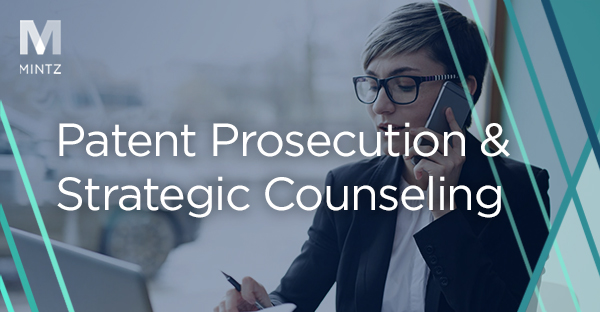
Patent Prosecution & Strategic Counseling
Viewpoints
Filter by:
Understanding Priority Claims for U.S. Patent Applications: Part 2
November 27, 2018 | Blog | By Christina Sperry, Elissa Kingsland
This article is second in a two-part series focusing on various issues related to priority claims in U.S. patent applications. While Part 1 is a general overview of how to make a proper priority claim, this article addresses how to make a timely post-filing priority claim in an application and how to correct an improper priority claim. Timeliness is crucial to avoid high fees and ensure that an earlier priority date is not lost. The procedures discussed below are post-America Invents Act (AIA) procedures applicable to applications and issued patents filed on or after March 16, 2013.
Read more
Prosecution Strategies for Avoiding Patent Eligibility Rejections for Diagnostics
November 19, 2018 | Blog | By Ken Jenkins
Under the Mayo/Alice test for patent eligibility, answering the questions of whether any particular claim is “directed to” a “judicial exception” without “significantly more” remains in many ways a substantial and unpredictable challenge for U.S. patent applicants in the diagnostic space. In cases where the detection processes are typically deemed “routine and conventional” (e.g., PCR) and the targets are known (e.g., expression of a known gene), claims must be crafted in ways that avoid rejections for both patent eligibility and anticipation and/or obviousness over the prior art. The recent PTAB decision in In re Srivastava et al. expressly addresses obviousness in this context, while highlighting a possible strategy for dealing with patent eligibility challenges as well (Appeal 2017-1981, Application 13/974,007, decided October 22, 2018; hereafter “In re Srivastava”).
Read more
European Patent Office Issues New Guidelines on Artificial Intelligence and Machine Learning
November 7, 2018 | Blog | By Michael Renaud, Marguerite McConihe
On November 1, 2018, the European Patent Office (“EPO”) issued new guidelines for the patentability of artificial intelligence (“AI”) and machine learning (“ML”) inventions which indicate that applications within this subject matter may be treated as largely unpatentable. The new guidelines, G-II 3.3.1, provide that AI and ML are “based on computational models and algorithms for classification, clustering, regression and dimensionality reduction, such as neural networks, genetic algorithms, support vector machines, k-means, kernel regression and discriminant analysis.” These “computational models and algorithms” are, according to the guidelines, “per se of an abstract mathematical nature.”
Read more
Medical Devices and the Intersection between FDA and Patent Law
October 2, 2018 | Blog | By Bradley Loos
Regulatory compliance is often treated as completely independent from development or enforcement of patent rights. This situation is not helped by the absence of coordination between the U.S. Food and Drug Administration (FDA) and the U.S. Patent and Trademark Office (USPTO). Still, companies must understand and appreciate the impact regulatory submissions may have on their patent portfolio.
Read more
10 Millionth U.S. Patent Issues Today
June 19, 2018 | Blog | By William Geary
Further to our previous blog post, the U.S. Patent and Trademark Office reported that the 10 millionth patent issued today with the new patent cover design.
Read more
Personalized Medicine Gets a Boost from Federal Circuit’s Vanda Pharma Decision – PART II: Enforcement
May 1, 2018 | Advisory
The Federal Circuit’s decision in Vanda Pharm. Inc. v West-Ward Pharm. Intl. Ltd. (2016-2707, 2016-2708 April 13, 2018) provided some good news on the subject matter eligibility front for innovators and other stakeholders in the personalized medicine space, as discussed in a previous post.
Read more
With Software Patents and Means-Plus-Function, “Structure” Takes On a New Meaning
April 17, 2018 | Blog
Software patents are generally directed to a sequence of steps or rules, i.e., an algorithm, performed by a computer programmed to carry out the algorithm. Because algorithms are inherently functional in nature, software patent claims are frequently written using functional, as opposed to structural, terms.
Read more
USPTO Prepares to Celebrate the Issuance of the Ten Millionth U.S. Patent
April 9, 2018 | Blog | By William B. Kezer
The United States Patent and Trademark Office (USPTO) anticipates issuing the 10 millionth utility patent at some point during the summer 2018.
Read more
Berkheimer v. HP Inc.: Whether Claim Elements Are Well-Known, Routine, or Conventional Is a Question of Fact
March 12, 2018 | Blog | By Michael Newman, Kevin Amendt
The Court of Appeals for the Federal Circuit ruled in February that it was wrong for a judge to rule that a patent was ineligible under the Alice standard because there were underlying factual disputes that could not be resolved on summary judgement.
Read more
Latest Tool in the Fight against Alice: USPTO Publishes a New Eligibility Quick Reference Sheet
February 26, 2018 | Blog | By Christina Sperry, Kevin Amendt
Struggling to keep case law relating to subject matter eligibility organized? In February 2018, the United States Patent and Trademark Office (USPTO) released an improved Eligibility Quick Reference Sheet, providing patent practitioners with a useful tool for analyzing claims in view of 35 U.S.C. § 101 subject matter eligibility requirements.
Read more
Updates to USPTO eMod Project to Improve E-Filing/Managing Patent Applications
February 22, 2018 | Blog | By Christina Sperry
The U.S. Patent and Trademark Office (USPTO) is implementing eCommerce Modernization (eMod), as discussed at a USPTO Patent Quality Chat webinar on February 13, 2018.
Read more
Patent Term Adjustment: Lessons Learned from the Federal Circuit Decision in Actelion v. Matal
February 14, 2018 | Blog | By Christina Sperry
On February 6, 2018, in Actelion v. Matal, the Federal Circuit affirmed the decision of the district court granting summary judgment in favor of the United States Patent and Trademark Office (PTO).
Read more
Information Disclosure Statements: When and How to File?
January 24, 2018 | Blog | By Christina Sperry, Elissa Kingsland
Under U.S. patent law, while there is no duty to perform a search of relevant art, inventors and those associated with filing or prosecuting patent applications as defined in 37 C.F.R. § 1.56 have a duty to disclose to the U.S. Patent and Trademark Office (USPTO) all known prior art or other information that may be “material” in determining patentability.
Read more
Have you ever used a one-click ordering process online? Then you indirectly paid Amazon.
January 8, 2018 | Blog | By Lisa Adams
If you purchased anything from a website using a one-click purchase button, you indirectly paid Amazon for that ability, at least up until September 11, 2017 when Amazon’s patent to this technology expired. As a result, one-click purchasing might become the new norm.
Read more
Patent Quality Chat: How Is A USPTO Examiner’s Work Product Reviewed?
December 4, 2017 | Blog | By Christina Sperry
In patent prosecution, the feedback loop between interested parties including patent prosecutors, inventors, and in-house counsel helps to provide the best patent applications and office action responses for a high quality issued patent.
Read more
Expediting Patent Prosecution with the New Expanded Collaborative Search Pilot Program
November 6, 2017 | Blog | By Christina Sperry
On November 1, 2017 the U.S. Patent and Trademark Office (USPTO) implemented an expansion of the Collaborative Search Pilot Program (CSP), which began in 2015 and ended earlier in 2017, to expedite prosecution of related applications at the USPTO and the Japanese Patent Office (JPO) or Korean Intellectual Property Office (KIPO).
Read more
Canada Institutes Certificates of Supplementary Protection for Approved Drug Products
October 6, 2017 | Blog | By Alex Trimble, PhD
On September 21, 2017, the Comprehensive Economic and Trade Agreement (CETA) signed between the European Union (EU) and Canada provisionally entered into force in Canada.
Read more
Recap on Design Patent Drawings
September 29, 2017 | Blog | By Christina Sperry, Inna Dahlin
This post is a follow-up to our prior post To Seek Design Protection or Not, That is the Question! where we discuss situations where it is worth considering seeking a design patent. Here we highlight takeaways from a USPTO Inventor Info Webinar (the “Webinar”) held on September 21, 2017, that focused on design patent drawing requirements, as well as on other issues on design patents.
Read more
Extension of U.S. Patent and Trademark Office’s Cancer Immunotherapy Pilot Program
June 28, 2017 | Blog | By Terri Shieh-Newton
On June 19, 2017, the U.S. Patent and Trademark Office (USPTO) announced that it would be extending the Cancer Immunotherapy Pilot Program, which permits patent applications pertaining to cancer immunotherapy to be examined in an expedited fashion.
Read more
USPTO eMod Project To Improve E- Filing/Managing Patent Applications
May 16, 2017 | Blog | By Christina Sperry
The U.S. Patent and Trademark Office (USPTO) is implementing eCommerce Modernization (eMod), as discussed at a Patent Quality Chat webinar on May 9, 2017.
Read more
Explore Other Viewpoints:
- Data Centers & Digital Infrastructure
- AI: The Washington Report
- Antitrust
- Appellate
- Arbitration, Mediation & Alternate Dispute Resolution
- Artificial Intelligence
- Awards
- Bankruptcy & Restructuring
- California Land Use
- Cannabis
- Class Action
- Complex Commercial Litigation
- Construction
- Consumer Product Safety
- Corporate Governance (ESG)
- Cross-Border Asset Recovery
- DEI Legal Developments
- Debt Financing
- Direct Investing (M&A)
- Diversity
- EB-5 Financing
- Education & Nonprofits
- Employment
- EnforceMintz
- Environmental (ESG)
- Environmental Enforcement Defense
- Environmental Law
- Environmental, Social, and Corporate Governance (ESG)
- FDA Regulatory
- False Claims Act
- Federal Circuit Appeals
- Financial Institution Litigation
- Government Law
- Growth Equity
- Health Care
- Health Care Compliance, Fraud and Abuse, & Regulatory Counseling
- Health Care Enforcement & Investigations
- Health Care Transactions
- Health Information Privacy & Security
- IP Due Diligence
- IPRs & Other Post Grant Proceedings
- Immigration
- Impacts of a New US Administration
- Insolvency & Creditor Rights Litigation
- Institutional Investor Class Action Recovery
- Insurance & Financial Services
- Insurance Consulting & Risk Management
- Insurance and Reinsurance Problem-Solving & Dispute Resolution
- Intellectual Property
- Investment Funds
- Israel
- Licensing & Technology Transactions
- Life Sciences
- Litigation & Investigations
- M&A Litigation
- ML Strategies
- Medicare, Medicaid and Commercial Coverage & Reimbursement
- Mergers & Acquisitions
- Patent Litigation
- Patent Prosecution & Strategic Counseling
- Pharmacy Benefits and PBM Contracting
- Portfolio Companies
- Privacy & Cybersecurity
- Private Client
- Private Equity
- Pro Bono
- Probate & Fiduciary Litigation
- Products Liability & Complex Tort
- Projects & Infrastructure
- Public Finance
- Real Estate Litigation
- Real Estate Transactions
- Real Estate, Construction & Infrastructure
- Retail & Consumer Products
- Securities & Capital Markets
- Securities Litigation
- Social (ESG)
- Special Purpose Acquisition Company (SPACs)
- Sports & Entertainment
- State Attorneys General
- Strategic IP Monetization & Licensing
- Sustainable Energy & Infrastructure
- Tax
- Technology
- Technology, Communications & Media
- Technology, Communications & Media Litigation
- Trade Secrets
- Trademark & Copyright
- Trademark Litigation
- Unified Patent Court (UPC)
- Value-Based Care
- Venture Capital & Emerging Companies
- White Collar Defense & Government Investigations
- Women's Health and Technology




